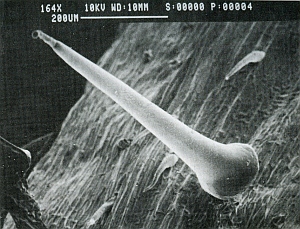
Contact-Poisonous Plants of the World
M. Rohde
Active Principles
Plants make use of different techniques to scare away unwanted visitors. The plants in the guide below are marked with symbols to indicate the techniques:

The most obvious defence mechanism a plant can use is mechanical, for example prickles, thorns, or barbs. Less visible but also purely mechanical are the sharp edges of certain grasses which can cause unpleasant cuts. Bamboos also belong to the botanical family of grasses, and some bamboo species bear thin bristles on the surface which can penetrate the skin and cause itching and irritation. There is an exceptional lot of mechanically active plants, and although injuries of the skin can cause secondary infections when dirt enters the human body, the mechanical principle is not subject of this document. Only the malicious and widespread Opuntia with its almost invisible, easily breaking off barbs is included in the list below.

The chemical agents of some plants are poisons that can enter the skin without mechanical action. When the sap of some species gets onto the skin surface it can lead to painful skin irritation or irreversible damages. Some species can even cause temporary or permanent blindness if a person touches broken parts of the plant and then the own eyes. Throwing such plant material into a fire can also be dangerous as the smoke can irritate the skin or also lead to blindness. Typical representatives of this principle belong to the Euphorbiaceae family. There are many members of other botanical families, however, that act similar. Another kind of plants like the Upas tree contain sap that is not skin-irritating but can be fatal if a very small amount of it gets into the bloodstream, for example through minor skin injuries.

The phototoxic principle occurs in a number of plants of which the best example is the Giant Hogweed. Phototoxic poison acts chemically, but only if the skin is exposed to sunlight at the same time.

A more sophisticated principle is the mechanical-chemical one: Plants penetrate the skin of the victim mechanically and introduce a poisonous chemical. The result is often immediate burning sensation of the skin. The best known representative of this kind of plants is the Stinging Nettle. Its closely related species are native to all parts of the world. Most mechanically-chemically acting plants belong to the botanical families Urticaceae and Euphorbiaceae, some of them being much more powerful than the Stinging Nettle. Under an electron microscope, fragile hollow needles become visible with nettle cells at their bases, filled with liquid poison. When touched, the needles break off, leaving oblique tips which can enter the human skin like syringes and release the poison.

Electron-microscope image of a stinging hair of Urtica dioica. Image: Y. Sell.

Another powerful principle, the allergizing principle, is found mainly in members of one botanical family called the Anacardiaceae. Infamous examples are the Toxicodendron species native to North America. The first encounter with one of them usually does not have any noticable consequences. But it allergizes the victim, and any subsequent contact can cause gradually more severe skin irritation.
Effects and Measures
After skin contact with one of the plants described here, typical symptoms are burning, redness, itching, swelling, or development of blisters. Chemical contact poisons are often oily substances which do not evaporate and thus can contaminate equipment for years. The poisons can be spread across the skin by scratching or they can get into the eyes when the eyes were rubbed with hands. People do react differently to the poisons and the effect of contact poisons is often increased when a person is exhausted or sweating. Washing with water and soap is generally a good idea. If stinging hairs or bristles are on the skin, they should first be removed with adhesive tape or tweezers. In severe cases a doctor must be consulted.
Geographical Distribution
For travellers, the danger of contact-poisonous plants depends on the region visited. The more harmful allergizing Toxicodendron species are native to North America, while the powerful mechanically-chemically active Dendrocnide species are mostly found in Australia. These are regions with highly efficient prevention and information distribution. However, it is the tropics where the most powerful contact-poisonous plants occur in great variety.
Plants which are not native to a region but have been introduced are marked with an asterisk(*).
North America
Cnidoscolus stimulosus
Cyanophyta (in water)
Heracleum mantegazzianum
Laportea canadensis
Metopium toxiferum (Southern USA)
Toxicodendron spp.
Urtica spp.
Europe
Cyanophyta (in water)
Heracleum mantegazzianum
Opuntia spp. (Southern Europe)*
Urtica spp.
North and East Asia
Cyanophyta (in water)
Toxicodendron vernicifluum
Urtica spp.
Australia and Oceania
Anacardium occidentale *
Cyanophyta (in water)
Dendrocnide spp.
Excoecaria agallocha
Laportea spp.
Mucuna spp.
Opuntia spp. *
Urtica spp.
Central and South America
Anacardium occidentale
Croton ciliato-glandulosus
Cyanophyta (in water)
Dieffenbachia spp.
Excoecaria agallocha
Hippomane mancinella
Hura crepitans
Jatropha urens
Metopium toxiferum
Mucuna spp.
Opuntia spp.
Urera baccifera
Urtica spp.
Africa
Anacardium occidentale *
Cyanophyta (in water)
Excoecaria agallocha
Laportea spp.
Mucuna spp.
Opuntia spp. *
Smodingium argutum
Urtica spp.
South and South-East Asia
Anacardium occidentale *
Antiaris toxicaria
Cyanophyta (in water)
Excoecaria agallocha
Girardinia leschenaultiana
Gluta renghas
Hippomane mancinella *
Holigarna arnottiana
Hura crepitans
Laportea spp.
Melanorrhoea spp.
Mucuna spp.
Opuntia spp .*
Semecarpus spp.
Swintonia floribunda
Tragia spp.
Urtica spp. (in mountains)
Guide to Contact-Poisonous Plants
By family names in botanical order, and alphabetically by scientific names within each family.
Disclaimer: The plant species listed here are toxic. This also applies to others which are not presented here. The information in this document have been compiled with care and accuracy. Correctness cannot be guaranteed, however. .
Blue-Green Algae

genus or species Microcystis spp., Anabaena spp., Lyngbya spp. etc
Different families of order Cyanophyta

Synonyms: Cyanobacteria (en), Blaualgen (de)
Occurrence: Worldwide, especially in warm regions, in seawater as well as in freshwater.
Description: These algae sometimes make water seem green in colour or sometimes form a blue-green scum on the surface. A bad (musty-earthy) smell may indicate the presence of these algae.
Effects: Chemical through algal toxins. Marine cyanobacterial dermatitis ("swimmers' itch" or "seaweed dermatitis") is a severe inflammation of the skin that may occur after swimming in water containing blooms of certain species of marine cyanobacteria. The symptoms are itching and burning within a few minutes to a few hours after swimming in an area where fragments of the cyanobacteria are suspended. Visible dermatitis and redness develop after 3 to 8 hours, followed by blisters and deep desquamation.
Measures: Washing of skin and eyes. Corticosteroid ointment. Antihistamine orally may be effective to relieve itching.
Reference : Mitchell/Rook; WHO Guidelines
Dieffenbachia

genus or species Dieffenbachia spp.
Araceae family (Arum family)
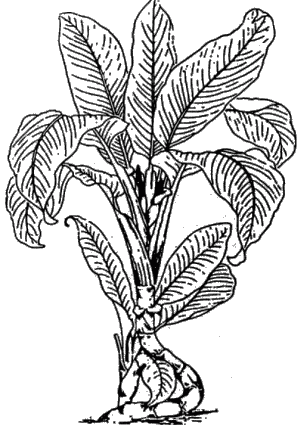
Synonyms: Dumb Cane (en), Dieffenbachie (de), Dieffenbachia (fr)
Occurrence: Home is tropical America in lowlands and damp areas. Popular indoor plant.
Description: Up to 1 m high plant with up to 25 cm long leaves with yellow pattern. Flourish butts of a yellow high sheet surround, blooms in March. It delivers a "skunk-like" smell when cut.
Effects: Mechanical-chemical through calcium oxalate crystals (in connection with other materials) in all parts of this plant, particularly in the stem. Freshly cut parts are very skin irritating. After one day rashes develop. Irreversible skin damage is possible. When brought into the eye, the sap can cause injury of the cornea. All parts are very poisonous when ingested.
Measures: Washing of skin or eyes. Corticosteroid ointment, Tetanus prophylaxis.
Reference : Roth; Benezra; Dahlgren; Behl
Giant Hogweed

genus or species Heracleum mantegazzianum Somm. & Lev.
Apiaceae (Umbelliferae) family (Carrot family)

Synonyms: Parsnip Tree (en), Riesen-Barenklau (de), Herkuleskraut (de)
Occurrence: Home is the Caucasus. In Europe and North America frequently used as an ornamental plant in gardens and parks, also wild in woodlands and waysides. Widespread in Scandinavia.
Description: Perennial shrub, 3 to 5 m high, leaves up to 1 m long. White blossoms in clusters up to 50 cm in diameter. Stem hollow, with red speckles, up to 10 cm in diameter. Period of bloom from July to September.
Effects: Sap from all parts of the plant, particularly from the stem, acts as a phototoxic. When the juice gets on the skin and the skin is then exposed to ultraviolet light (some hours in the sun may be enough), the skin reddens next day, after another day a strong blistering can occur. The skin changes resemble second-degree burns. Often scars or pigment changes remain permanently or last for years. Also poisonous when ingested.
Measures: Avoid either the plant's sap or the sunlight. The sap can be washed away with water and soap. Corticosteroid ointment. See a doctor if necessary.
Reference: Benezra; Roth; "Der Spiegel" Nr. 33/1989; "JAMA" Dec 12/1980 Vol 244 No 23
Similar plants: Heracleum sphondylium (Cow Parsnip) is similar in appearance and effect, only up to 1.50 m in size, widespread in Europe. Similar plants include other Heracleum species as well as Pastinaca sativa and Angelica archangelica (also beloning to the Apiaceae family).
Cowhage

genus or species Mucuna pruriens Dc.
Fabaceae (Leguminosae) family (Legume family)
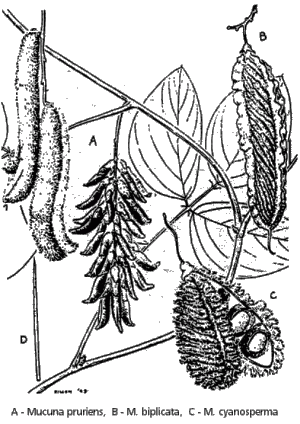
Synonyms: Cow-Itch (en), Juckbohne (de)
Occurrence: Entire tropics in bushes and secondary forests.
Description: Creeper with whitish-greenish to purple or red inflorescences. Blossoms sometimes hairy. Pods 10 to 13 cm long, covered with approx. 5000 hairs which easily break off. The hairs on fruit and blossom are 1 to 2.5 mm long, have barbs and contain itch-producing Mucunain.
Effects: The hairs act as a mechanical-chemical skin-irritant. If only one of the hairs gets on the skin, itch can already be felt. Reddening of the skin and small papules or urticaria occur a few minutes after contact with the hairy parts of the plant. The hairs of Mucuna break off easily and can contaminate clothes or other objects. Dried parts of the plant remain active. There is no serious danger, except when the hairs get into the eye. In this case even blindness is likely.
Measures: To remove the hairs from the skin, adhesive tape and washing with water and soap are considered useful. Dermatitis can be treated with corticosteroid ointment. See a doctor immediately if hairs got into the eyes.
Reference: "JAMA" Jan 17/1986 Vol 255 No 3; Merrill(1); Roth; Behl
Similar plants: The related species of Mucuna biplicata, M. cyanosperma, M. atropurpurea, M. gigantea, M. hirsuta, M. monosperma, M. nigricans. M. melanocarpa in Ethiopia. There are also harmless Mucuna species, however.
Indian Fig

genus or species Opuntia spp.
Cactaceae family (Cactus family)
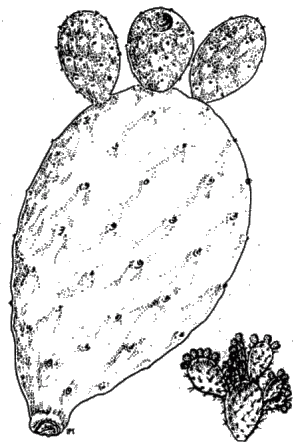
Synonyms: Sabra (en), Opuntie (de)
Occurrence: Approximately 200 species are native in tropical and subtropical America, also introduced to other continents. Frequently found in dry places. Also popular as a house plant.
Description: Cactuses in the form of shrubs or small trees with oval, flat segments and wide funnel-shaped yellow or red blossoms. Petals small, cylindrical, drop a short time after they appear. Opuntia can be an important survival plant in the desert: The egg-shaped fruits are edible uncooked when peeled. Clear potable water can be squeezed out of the segments. Peeled young segments are edible after cooking.
Effects: Mechanical, partly chemical. Most cactuses are armed with thorns, but Opuntia is among the most unpleasant ones because its fine thorns break off after the lightest touch and penetrate the skin easily. If dirt covers the plant, it can enter the skin with the thorns. Contact with the plant can result in papules and pigment changes which disappear after several months. The symptom is named Sabra Dermatitis and resembles scabies.
Measures: As far as possible, remove the thorns carefully from the skin with adhesive tape or a pair of tweezers. Tetanus prophylaxis.
Reference: Behl; Benezra
Similar plants: Other Cactus species.
Upas

Antiaris toxicaria Lesch
Moraceae family (Mulberry family)

Synonyms: Antiaris, Ipoh
Other scientific names: Upas antiar Lesch.
Occurrence: Tropical Asia, east to Timor. Notably Java, Sulawesi and the islands nearby. Tonga. Tropical Africa south to Angola and Zambia.
Description: Large evergreen tree up to 75 m tall, often with buttresses at the base of the trunk. Fruits reddish, fleshy, velvety, 20 x 13 mm, on a 10 mm long stalk, containing 1 seed each. Highly poisonous, milk-white or yellowish latex in leaves and bark. It turns brownish and waxy when exposed to air.
Effects: The latex is highly poisonous. It partially dissolves in alcohol. On some individuals it causes swellings and eruptions on the skin. Small doses in the bloodstream act upon the vasomotor centers, producing increased arterial tension. Larger doses can paralyze the heart muscle and result in death. A skin abrasion caused by a broken branch can already kill a person, and the wood of this tree is definitely unsuitable as building material. The latex (also called Ipoh in Malay) was traditionally used by hunters to prepare poisoned arrows.
Measures: [Not described in literature.] Immediate washing of the skin with water and soap should help removing the latex.
Reference: Merrill(2); Felter; Flora of Ethiopia
Similar plants: Other subspecies of Antiaris occurring in Australia and Madagascar. There are other types of several botanic families which contain highly poisonous sap in certain parts, which should under no circumstances get into the bloodstream, like the seeds of Abrus precatorius and Strychnos nux-vomica.
Bull Nettle

Cnidoscolus stimulosus
Euphorbiaceae family (Rubber family))
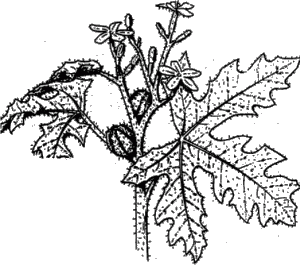
Synonyms: Spurge Nettle (en), Tread-Softly (en
Occurrence: South-eastern USA from Virginia south to Florida and Texas. On waysides, fields, and sandy grounds.
Description: Height up to 60 cm. The white blossoms appear from the end of March to September. All parts above the ground are covered with stinging hairs.
Effects: Mechanical-chemical by stinging hairs. After touching severe burning and itching occurs immediately. Reddening of the skin and perhaps blistering.
Measures: Corticosteroid ointment, medical attention, Tetanus prophylaxis.
Reference: Peterson
Ciega-vista

Croton ciliato-glandulosus
Euphorbiaceae family (Rubber family)

Occurrence: Central America and Mexico. Frequently in the underwood in dry locations.
Description: Up to 1 m tall shrub with small light green blossoms. leaves and stalks are covered with whitish hairs.
Effects: The hairs of the plant cling to the hands when touched. If these come then in contact with the eyes, serious eye inflammations can result. Cattle grazing between these shrubs have been reported to have gone blind.
Measures: Washing hands after touching the plant. If hairs got into the eyes, rinse eyes with water and search medical attention immediately.
Reference: Dahlgren
Blinding Tree

Excoecaria agallocha L.
Euphorbiaceae family (Rubber family))

Synonyms: Blind-Your-Eye (en), Buta-Buta (id
Occurrence: In many parts of the tropical world in mangrove forests and brackish swamps.
Description: Small tree up to 14 m tall, resembling the Mangrove, with leaves 6 to 10 cm long, alternate and evergreen. The tiny, fragrant blossoms are yellowish-green, the fruits resemble peas. The plant contains a milky sap.
Effects: Chemical. When the latex gets into the eye, this can result in blindness. When it gets on the skin, severe burning, inflammation, blistering and permanent damage are to be expected. All parts of the plant are also poisonous when ingested. The plant is known to be a fish poison.
Measures: Washing of the skin, application of corticosteroid ointment. Immediate washing of the eyes with water, professional medical treatment.
Reference: Behl
Similar plants: Most members of the Rubber Family (Euphorbiaceae) contain a milky sap which is skin-irritating and very poisonous, sometimes also carcinogenic.
Manchineel Tree

Hippomane mancinella L.
Euphorbiaceae family (Rubber family)
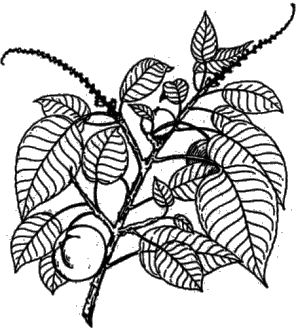
Synonyms: Manchioneal (en), Manzanillo-Baum (de)
Occurrence: Native in tropical America, growing in dense groups along ocean beaches. Occasionally cultivated in India and other tropical countries.
Description: Small branching tree with light brown smooth bark and very small green blossoms. The fruits resemble small green apples. The tree contains a milky sap.
Effects: Chemical. On the skin the sap (after approx. one half an hour) induces a violent burning sensation, together with inflammations and vesicles or rashes with subsequent abrasion of the epidermis. If a small drop of the caustic latex or the smoke of the burning tree gets into the eyes, blindness can be the result. Even raindrops falling from a Manchineel tree can cause skin damages and severe eye irritation. All parts of the plant are also very poisonous and carcinogenic when ingested.
Measures: Washing of the skin, application of corticosteroid ointment. Rinse eyes immediately with water. Cover blisters sterilely. Tetanus prophylaxis, medical treatment.
Reference: Roth; Dahlgren
Similar plants: Most members of the Rubber Family (Euphorbiaceae) contain a milky sap which is skin-irritating and very poisonous, sometimes also carcinogenic
Sand-Box Tree

Hura crepitans L.
Euphorbiaceae family (Rubber family)

Synonyms: Sandbüchsenbaum (de), Jabillo (es)
Occurrence: Home of this tree is tropical America. Occasionally cultivated in India and other tropical countries. Grows at low altitudes.
Description: A tree up to 25 m tall. The bark is covered with lots of short spines. Inconspicuous reddish-brown blossoms. The woody fruits resemble small pumpkins and explode with a loud bang when ripe. Therefore, it can be dangerous to handle them. The tree contains a milky sap.
Effects: Chemically skin-irritating by the caustic latex. When brought into the eye it can cause cornea damages or even loss of sight. Also poisonous when ingested. The parts of this plant are poisonous also for fish and insects and therefore traditionally used as fish poison.
Measures: Washing of the skin, application of corticosteroid ointment. Immediate washing of the eyes with water, professional medical treatment.
Reference: Roth; Dahlgren; Behl
Similar plants: Most members of the Rubber Family (Euphorbiaceae) contain a milky sap which is skin-irritating and very poisonous, sometimes also carcinogenic.
Stinging Spurge

Jatropha urens L.
Euphorbiaceae family (Rubber family)

Occurrence: Tropical America and the Caribbean at low and middle altitudes.
Description: Bush, shrub, or small tree with white blossoms and milky latex. The whole plant is covered with long rigid stinging hairs.
Effects: Mechanical-chemical through stinging hairs. A slight touch can cause severe burning and pain, often with insensitivity of the affected skin area for a day or longer. Frequently blistering.
Measures: Corticosteroid ointment, medical attention, Tetanus prophylaxis.
Reference: Dahlgren
Noseburn

Tragia spp.
Euphorbiaceae family (Rubber family)
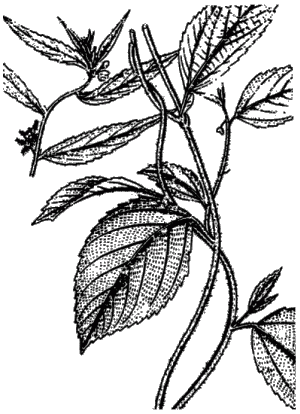
Occurrence: Throughout India. The genus Tragia is represented there with different species.
Description: Perennial climber with stinging hairs. Leaves alternate and unpinnated or fingerlike 3-pinnated, bearing capsule fruits.
Effects: Mechanical-chemical by stinging hairs. Skin irritation and inflammation is possible after touching the plant.
Measures: Corticosteroid ointment, Tetanus prophylaxis.
Reference: Behl
Giant Stinging Tree

Dendrocnide excelsa Chew.
Urticaceae family (Nettle family)

Synonyms: Giant Stinger (en)
Occurrence: Australia from the Bunya mountains in Queensland to Kiama in New South Wales. Widespread in rain forests, particularly on slopes and in canyons. Has related species in the whole Pacific area.
Description: Tree up to 40 m tall, with buttresses at the base of the trunk. Leave tops covered wirh fluffy hairs, bottom sides covered with stinging hairs. Male and female blossoms are on different specimens.
Effects: Mechanical-chemical by stinging hairs which break off when touched and inject a poison into the skin. Immediate burning sensation and itching will follow, including reddening and blistering. The burning can last for weeks. Even raindrops that fall from Dendrocnide can probably irritate the skin.
Measures: Tetanus prophylaxis, corticosteroid ointment, medical attention.
Reference: Flora of Australia
Similar plants: 36 smaller Dendrocnide species, all with nettle hairs, in the Pacific region, including Dendrocnide corallodesme in Queensland, Australia, and New Guinea, in rain forests, growing 6 m tall with elongated leaves which resemble those of the Mango tree.
Gympie

Dendrocnide moroides
Urticaceae family (Nettle family)

Occurrence: Queensland and East coast of Australia, from Cape York in the north to Victoria in the south. Along tracks, along the banks of creeks, and in rain forests.
Description: Tree up to 5 m tall with stinging hairs on leaves, young branches, and fruits. Fruits are edible.
Effects: Mechanical-chemical through stinging hairs. This is reported to be the most painful of all stinging trees. The stinging hairs break off when touched and inject a poison into the skin. Immediate burning sensation and itching will follow, including reddening and blistering. The burning can last for weeks. People can suffer even if they don't touch the plant. These trees continuously shed their stinging hairs. Staying close to a stinging tree for more than an hour can cause painful and continuous bouts of sneezing.
Measures: Tetanus prophylaxis, corticosteroid ointment, medical attention.
Reference: Kruszelnicki
Similar plants: 36 other Dendrocnide species, all with nettle hairs, in the Pacific region, including Dendrocnide corallodesme in Queensland, Australia, and New Guinea, in rain forests, growing 6 m tall with elongated leaves which resemble those of the Mango tree.
Nilgiri Nettle Dcne.

Girardinia leschenaultiana
Urticaceae family (Nettle family)

Occurrence: India, China, South-East Asia. Forest margins, along streams, altitude 1500-2800 m.
Description: Perennial herb, elliptic leaves, lobed or serrate, inflorescences 5-10 cm.
Effects: Mechanical-chemical by stinging hairs. After touching the plant burninging sensation and itching can occur, later reddening of the skin and perhaps blistering.
Measures: Corticosteroid ointment, medical attention, Tetanus prophylaxis.
Reference: Behl; Flora of China
Wood Nettle

Laportea canadensis
Urticaceae family (Nettle family)

Occurrence: North America from Canada to Florida. Frequentlyfound in low forests and on riverbanks. The plant prefers grounds rich in nutrient.
Description: Up to 1.10 m high shrub with greenish blossoms, flowering from June to September. Parts above the ground are covered with stinging hairs. In contrast to the Stinging Nettle, leaves are alternate.
Effects: Mechanical-chemical through stinging hairs. After touching the plant burning and itching may occur, including reddening of the skin and perhaps blistering. Young leaves are edible when cooked.
Measures: Usually none. Sap from Impatiens or Rumex species can alleviate the effect. In more severe cases apply corticosteroid ointment, search medical attention, get Tetanus prophylaxis.
Reference: Peterson
Tree Nettle

Laportea spp.
Urticaceae family (Nettle family)
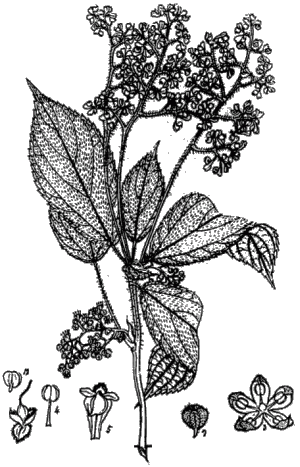
Synonyms: Fever Nettle (en)
Occurrence: Frequently found in subtropical and tropical regions in Europe, Asia, and Australia. Also in secondary forests and thickets.
Description: Shrub or small tree with inconspicuous white or greenish blossoms. Leaves are covered with stinging hairs, mostly also leaf stalks and other parts.
Effects: Strong mechanical-chemical skin irritation by stinging hairs. After slightly touching the plant severe burning sensation or itching can occur. Later skin reddening and often blistering. Sleeplessness and fever can occur when large areas of the skin are affected.
Measures: Bath affected skin areas in soap solution. Corticosteroid ointment, medical attention, Tetanus prophylaxis.
Reference: Merrill (1)
Nettle Tree

Urera baccifera
Urticaceae family (Nettle family)
Synonyms: Ortiga (es), Chichicaste (es)

Occurrence: In tropical America frequently found at low and middle altitudes. Sometimes cultivated as hedge plants.
Description: Small bush, shrub or tree, covered with stinging hairs.
Effects: Severe mechanical-chemical skin irritation through stinging hairs. After slightly touching burninging sensation and itching. Later reddening and often blistering. Sleeplessness and fever can occur when extensive areas of the skin are affected. If leaves streak the body, this can already cause severe pain which can last for 24 hours.
Measures: Bath affected skin areas in a soap solution. Corticosteroid ointment, medical attention, Tetanus prophylaxis.
Reference: Dahlgren
Stinging Nettle

Urtica dioica L.
Urticaceae family (Nettle family)
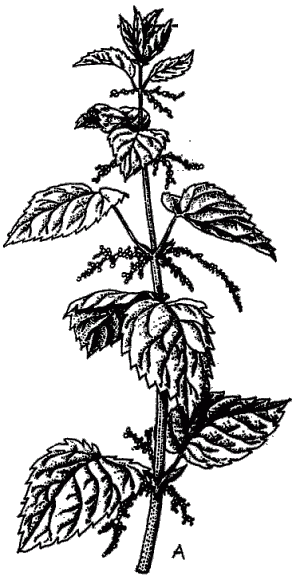
Synonyms: Common Nettle (en), Große Brennnessel (de)
Occurrence: These and other Urtica species are widespread world-wide on waysides, in margins of forests, in residential areas, and on rubble. In the tropics only at high altitudes.
Description: Up to 1.5 m high perennial shrub with an unbranched upright stem. Blossoms greenish, blooming period from July to October in the northern temperate zone. Parts above ground are covered with stinging hairs.
Effects: Mechanical-chemical through stinging hairs. After slightly touching the plant, burning sensation and itching may occur, including reddening of the skin and perhaps blistering. The young leaves are sometimes used as vegetables, the poisonous effect disappears after cooking.
Measures: Usually none. The sap of Rumex species (Sorrel, often found near to Stinging Nettles) can be used for alleviation. Corticosteroid ointment, medical attention, Tetanus prophylaxis in severe cases.
Reference: Roth; Benezra
Similar plants: Urtica urens (also called Stinging Nettle), appearance very similarly, but only up to 60 cm and annual. More than 500 other Urtica species world-wide.
Cashew Nut Tree

Anacardium occidentale L.
Anacardiaceae family (Sumac family)

Synonyms: Kaschu (de), Acaju (es)
Occurrence: Resident in tropical America but also widespread in all other tropical countries because the nuts are cultivated. This tree prefers dry ground and is usually not found in forests.
Description: Evergreen tree up to 10 m tall with leathery leaves, white blossoms with pink stripes and a fruit which consists of two parts: The upper part (the Cashew apple) is red, yellow or white and contains white edible pulp (tasting sweet and slightly peppery). The lower part of the fruit is grey and very skin-irritating. It contains the Cashew nut which is edible only after being roasted.
Effects: Chemically skin-irritating and allergizing. The plant's sap from bark, leaves and particularly the nutshell can within one day cause painful skin alterations which resemble second-degree burns. This sap is brown and oily and becomes black when exposed to the air. The fumes which emerge from roasting the nuts are skin-irritating and can even lead to blindness.
Measures: Take extreme caution when harvesting nuts or fruits and also when roasting the nuts. Corticosteroid ointment, medical attention, Tetanus prophylaxis.
Reference: Benezra; Behl; Roth; Dahlgren
Rengas

Gluta renghas L.
Anacardiaceae family (Sumac family)

Occurrence: South-East Asia and India.
Description: Tree.
Effects: Allergizing and chemically skin-irritating. The smoke of the burning wood can also be dangerous.
Measures: Corticosteroid ointment, medical attention, Tetanus prophylaxis.
Holigarna

Holigarna arnottiana Hook.f.
Anacardiaceae family (Sumac family)
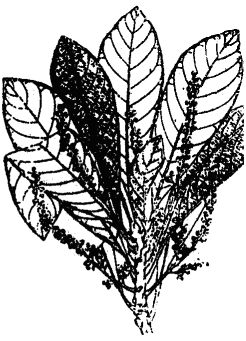
Occurrence: Western India in evergreen forests.
Description: Tall tree, the treetop being closely covered with leaves. Leaves are large and hairless. Fleshy, oval stone fruits (drupes) in clusters. Small blossoms.
Effects: Allergizing and chemically skin-irritating. The smoke of the burning wood can also be dangerous.
Measures: Corticosteroid ointment, medical attention, Tetanus prophylaxis.
Reference: Behl
Similar plants: Melanochyla und Campnosperma act similar; they are found in the Indo-Malaysian area.
Burma Lac Tree

Melanorrhoea usitata Wall.
Anacardiaceae family (Sumac family)
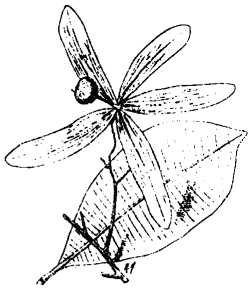
Synonyms: Burmese Lacquer Tree (en), Rengas (id)
Occurrence: Manipur (East India), Burma, Thailand.
Description: Tall deciduous tree, twigs and leaves hairy, blossoms white, flowering from January to March. Stone fruit (drupe) reddish and fleshy, approx. 1 cm in diameter. The tree is sometimes cultivated for the black Burma Lacquer which is gathered from the bark.
Effects: Allergizing and chemically skin-irritating. The smoke of the burning wood can also be dangerous.
Measures: Corticosteroid ointment, medical attention, Tetanus prophylaxis.
Black Poison Wood

Metopium toxiferum Krug.
Anacardiaceae family (Sumac family)

Synonyms: Poison Bark (en), Doctor's Gum (en)
Occurrence: West-Indies, Bahamas, Southern Florida, Yucatan, Belize, Cuba, Jamaica. Frequently found in open areas.
Description: Shrub or small tree up to 12 m tall, bark yellowish-brown, wide open branches. The 3- to 7-fold leaves are light green and up to 30 cm long, shiny on top and dull underneath. Blossoms white, berries yellow to orange. The latex sometimes emerges by itself from bark and leaves and becomes black when exposed to air.
Effects: Chemically skin-irritating and allergizing. After contact with the latex 70% of the Europeans develop itching papules a few days later which develop into blisters and remain for several weeks. The smoke of the burning wood is also skin-irritating.
Measures: Corticosteroid ointment, medical attention, Tetanus prophylaxis.
Reference: Jackson; Dahlgren
Marking Nut Tree

Semecarpus anacardium L.
Anacardiaceae family (Sumac family)
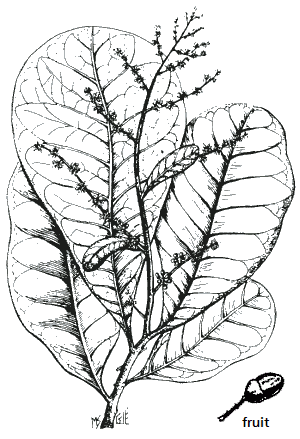
Synonyms: Bhilawa Tree (en), Kidney Bean of Malacca (en), Ostindischer Tintenbaum (de), Markfruchtbaum (de)
Other scientific names: Anacardium orientale Steud.
Occurrence: Resident in tropical India but also occasionally cultivated in other tropical countries. Growing wild in secondary forests and thickets.
Description: Deciduous tree up to 13 m tall with leathery, 20 to 60 cm long leaves. Blossoms yellowish-green, fruits black, 25 mm long. The fruit shell contains a black sap (ink), the pulp is orange, sweetish and reported to be edible.
Effects: The black sap of the fruit shell can cause itching a half day after contact and rashes and blistering within 24 hours. In Indian laundries the ink is sometimes used to mark clothes. In sensitive people these marks can also cause skin rashes after wearing the clothes, even after repeated laundering.
Measures: Cover blisters sterilely, apply corticosteroid ointment. Remove ink marks from clothes.
Reference: Roth; Behl; Benezra; Goldsmith
Ligas

Semecarpus cuneiformis Blanco.
Anacardiaceae family (Sumac family)

Occurrence: In the Philippines and on the island of Sulawesi, Indonesia. Widespread in thickets at low altitudes.
Description: Shrub or small tree, 3 to 8 m high. Leaves 10 to 25 cm long. Blossoms whitish, 2 to 2.5 mm long, flowering in the Philippines from January to March. Stone fruit (drupe) 1 cm long, the upper part of the fruit is reddish, fleshy, and edible.
Effects: Very allergizing and skin-irritating. Dropping rain can cause skin rashes.
Measures: Cover blisters sterilely. Corticosteroid ointment, medical attention, Tetanus prophylaxis.
Reference: Hanewald
Similar plants: Semecarpus forstenii and S. heterophylla on Sumatra and Java, named Rengas there, act similarly strong.
Rainbow Leaf

Smodingium argutum E.Mey.
Anacardiaceae family (Sumac family)

Synonyms: African Poison Ivy (en)
Occurrence: South Africa.
Description: Upright or climbing shrub or small deciduous tree up to 5 m tall. Twigs slim and smooth. Leaves alternate, on long stalks, divided into three parts, each of which are 10 to 12 cm long. Small blossoms in hairy panicles. Fruit flat and winged.
Effects: Allergizing. Some people react after contact with scattered skin rashes which are usually severe. Responsible for this is the sap of the plant.
Measures: Corticosteroid ointment, medical attention if necessary.
Reference: Benezra; Whiting
Rengas

Swintonia floribunda Griff.
Anacardiaceae family (Sumac family)

Occurrence: Southern Burma.
Description: Evergreen tall hairless tree, flowering from December to March with lots of light yellow blossoms. Stone fruit (drupe) surrounded by violet petals.
Effects: Allergizing and chemically skin-irritating. The smoke of the burning wood can also be dangerous.
Measures: Corticosteroid ointment, medical attention, Tetanus prophylaxis.
Western Poison Oak

Toxicodendron diversilobum Greene.
Anacardiaceae family (Sumac family)

Synonyms: Pacific Poison Oak (en)
Other scientific names: Rhus diversiloba Torr.&Gray., Toxicodendron lobadioides
Occurrence: West coast of North America from British Columbia to Mexico in wooded slopes and thickets.
Description: Crawling shrub up to 3 m heigh or climbing up to 40 m. See Eastern Poison Oak.
Effects: See Toxicodendron species in general.
Measures: See Toxicodendron species in general.
Reference: U.S. Department of Health; Benezra; Roth; Peterson
Eastern Poison Oak

Toxicodendron quercifolium Michx.
Anacardiaceae family (Sumac family)

Occurrence: North America, particularly in the south-east of the USA in dry woodlands.
Description: Up to 1 m high shrub with threefold leaves. Single leaflets 3 to 7 cm long, lobed, slightly hairy underneath and brighter than on the top side. Flowering from May to June. Fruits hanging. See Poison Ivy.
Effects: See Toxicodendron species in general.
Measures: See Toxicodendron species in general.
Reference: U.S. Department of Health; Benezra; Roth; Peterson
Poison Ivy

Toxicodendron radicans L.
Anacardiaceae family (Sumac family)

Synonyms: Eastern Poison Ivy (en), Giftefeu (de)
Other scientific names: Rhus toxicodendron Linn., Rhus radicans Linn.
Occurrence: Throughout North America, particularly in the eastern and central parts of the USA. Frequently found in forests and on fields, in rocky canyons and on river banks. At altitudes below 1300 m.
Description: Crawling shrub up to 2 m heigh, sometimes climbing higher. Leaves greenish, sometimes shiny, long-stalked, 10 to 35 cm long and threefold. Middle leave on a longer stalk. Young leaves orange to brown with yellowish veins. Flowers in June, yellowish green, 5 mm. Fruits are hard berries in the shape of a peeled Orange, 5 to 7 mm in diameter, greenish-white or yellowish, from August to March. Young parts of the plant slightly hairy. The plant contains a latex which gets dark in a few minutes when exposed to air.
Effects: See Toxicodendron species in general.
Measures: See Toxicodendron species in general.
Reference: U.S. Department of Health; Benezra; Roth; Peterson
Japanese Laquer Tree

Toxicodendron vernicifluum Stokes.
Anacardiaceae family (Sumac family)

Synonyms: Varnish Tree (en), Lacksumach (de), Urushi (jp)
Other scientific names: Rhus verniciflua Stokes., Rhus vernicifera Dc.
Occurrence: Native of Japan, Central and western China. Also cultivated in other regions for the production of Japanese lacquer.
Description: 15 to 20 m tall tree with 7- to 13-fold leaves. Single leaflets are 10 to 20 cm long and 3 to 7 cm wide. Berries are straw-coloured, 10 mm in diameter. Appearance like Toxicodendron vernix. The milky latex turns black in a few minutes when exposed to air.
Effects: The sap acts skin-irritating chemically and is allergizing. The dried lacquer is skin-irritating only for very few people.
Measures: See Toxicodendron species in general.
Poison Sumac

Toxicodendron vernix L.
Anacardiaceae family (Sumac family)
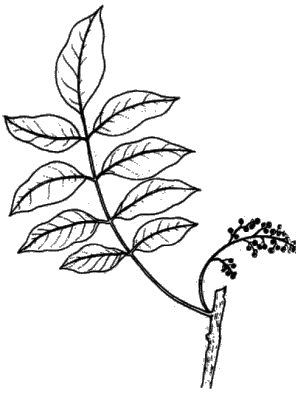
Synonyms: Giftsumach (de)
Other scientific names: Rhus vernix L., Rhus venenata Dc.
Occurrence: North America, particularly in the east in swampy areas.
Description: Shrub or small tree up to 3 m, rarely up to 7 m. Twigs orange to brown, later becoming grey. Leaves up to 40 cm long and 7- to 13-fold. Single leaflets shorter than 10 cm. Inflorescences with fluffy hairs and longer than 10 cm. Berries white, hard, sperical, smooth, 5 mm in diameter, yellowish or grey in hanging clusters. (Harmless Sumac species, on the contrary, have red fruits).
Effects: See Toxicodendron species in general.
Measures: See Toxicodendron species in general.
Reference: U.S. Department of Health; Benezra; Roth; Peterson
Toxicodendron Species in General

Toxicodendron spp.
Anacardiaceae family (Sumac family)
Effects: Allergizing through urushiol in the resin of the plants. Through small injuries of the plant the resin can escape in low amounts from the leaf surface and from there get on the skin of a person who touches the leaf. Such small amounts can be already enough to induce an allergy. The allergen penetrates through the unhurt skin into the human body. However, the first contact remains mostly without any reaction. Subsequent contacts with a plant with any parts of the skin can induce rashes which appear right there and at the parts of the skin affected in earlier contacts. 24 to 48 hours after contact, itching, reddening, swelling, and wetting blisters use to appear. Against common opinion the liquid contained in the blisters is not an allergen and can transfer the rashes not to other people. However, this can happen by resin that remained on the skin.
The symptoms reach their climax approximately during the fifth day, then they heal without treatment in 1 to 2 weeks without leaving scars. However, secondary infections are possible if the blisters are not kept sterile. Abscesses or fever may occur then and scars can remain. If the poison gets into the eyes, severe inflammations and temporary or remaining cornea turbidity can follow. The allergy induced by the first contact usually lasts many years.
50% of the Americans react to slight contacts. Only 30% do not react at all. The poison is present in the plants also in winter, and also in dead and decaying plants. Smoke particles of burning parts of the plant spread the poison and can affect the skin and the respiratory tract. The allergen is spread easily, for example by shaking hands or via the fur of straying pets. The urushiol remains active outside the plant during at least 1 year and is not soluble in water. It is soluble in soap solution, though.
Measures: Thorough washing of the skin with water and soap as soon as possible after contact with the plant. If the skin is being washed within few hours this will likely prevent the reaction. Alcohol is unsuitable for cleaning because it accelerates the penetration of the poison into the skin. If no soap is available, the sap of Impatiens plants may also help. Rinsing the skin in flowing water is better than doing nothing at all. Rashes can be alleviated with corticosteroid ointment, while severe reaction needs medical attention. With very sensitive people it may be necessary to prevent allergic reactions with corticosteroids taken orally within 24 hours after contact. If one wants to remove Toxicodendron plants from a garden, they must be dug out with all roots.
Reference: U.S. Department of Health; Benezra; Roth; Peterson
Reference
Benezra, Claude; Georges Ducombs; Yves Sell; Jean Foussereau: Plant Contact Dermatitis. Toronto/Philadelphia, 1985.
Behl, P.N.; R.M.Captain: Skin-Irritating and Sensitizing Plants Found in India. New Delhi, 1979.
Dahlgren, B.E.; Paul C. Standley: Edible and Poisonous Plants of the Caribbean Region. US Government Printing Office, Washington DC, 1944.
Du Buisson, Max: Nettles (seminar). Department of Biology, Davidson College, 2001.
Evans, Fred J.; R.J.Schmidt: Plants and Plant Products That Induce Contact Dermatitis. In: Planta Medica, April 1980.
Goldsmith, Norman R.: Dermatitis from Semecarpus anacardium. In: Journal of the American Medical Association (JAMA), Sept. 27, 1943.
Guidelines for Safe Recreational Water Environments. Volume 1, Coastal and Fresh Waters. World Health Organization 2003.
Gunby, Phil: Mucuna Pruriens Associated Pruritis. In: Journal of the American Medical Association (JAMA), Jan. 17, 1986.
Hanewald, Roland: Das Tropenbuch. 3. Aufl. Berlin, 1987.
Jackson, W.P.U.: Plant Dermatitis in the Bahamas. In: British Medical Journal, Aug. 31, 1946.
Keep Away from That Tree, Folks! In: Journal of the American Medical Association (JAMA), Dec. 12, 1980.
Felter, Harvey Wickes; John Uri Lloyd: King's American Dispensatory. 1898.
Kruszelnicki, Karl S.: Great Moments in Science. Stinging Trees. 2003.
Lampe, Kenneth Francis: Common Poisonous and Injurious Plants. US Government Printing Office, Washington DC, 1981.
Lampe, Kenneth Francis; Rune Fagerström: Plant Toxicity and Dermatitis. Baltimore, 1968.
Merrill, Elmer D.: Dermatitis Caused by Various Representatives of the Anacardiaceae in Tropical Countries. In: Journal of the American Medical Association (JAMA), Jan. 22, 1944.
Merrill, Elmer D.: Emergency Food Plants and Poisonous Plants of the Islands of the Pacific. US Government Printing Office, Washington DC, 1943.
Merrill, Elmer D.: Plant Life of the Pacific World. Rutland/Vermont/Tokyo, 1984.
Mitchell, John; Arthur Rook: Botanical Dermatology. 1979, 2001.
Peterson, Lee Allen: A Field Guide to Edible Wild Plants. Boston, 1977.
Poison Ivy Allergy. US Department of Health and Human Services, US Government Printing Office, Washington DC, 1985.
Roth, Lutz; Max Daunderer; Kurt Kormann: Giftplanzen - Pflanzengifte. 3. Aufl. Landsberg/Lech, 1988.
Schoser, Gustav: Tropicarium. Palmengarten Frankfurt/Main, 1987.
Starke Triebwirkung. In: Der Spiegel Nr. 33/1989.
Survival. Field Manual 21-76. Headquarters Department of the Army, 1992.
Whiting, D.A.: Plant Dermatitis in the Southern Transvaal. In: South African Medical Journal, Febr. 13, 1971.
Woods, Brian: Irritant Plants. In: Transactions of the St John's Hospital Dermatological Society, London, 1962.